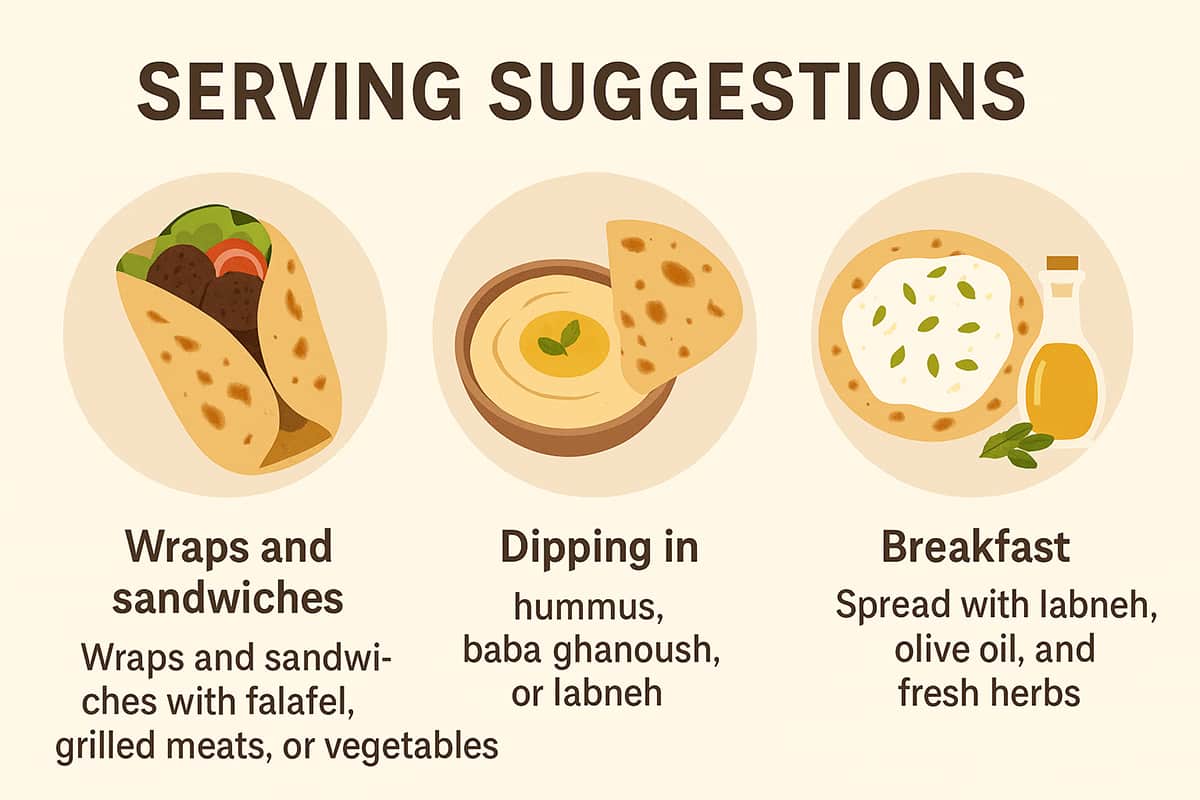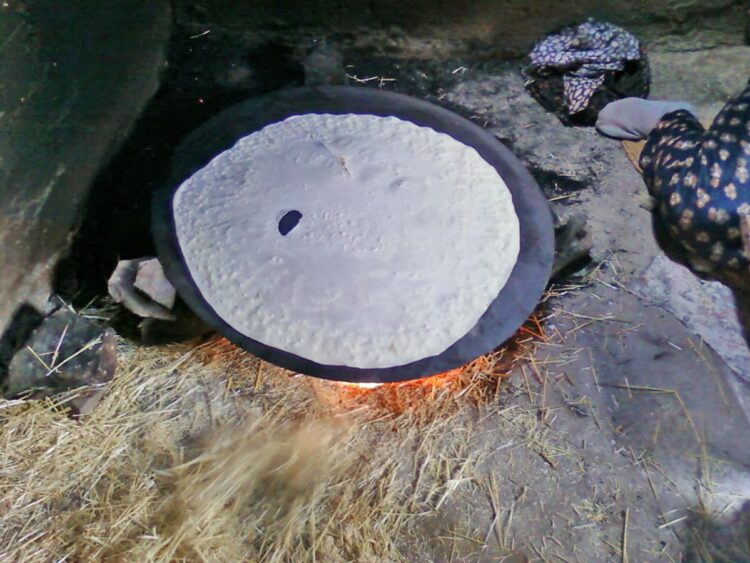If you’ve ever walked the bustling streets of Beirut, you’ve likely smelled the unique aroma of bread baking on a griddle called a Saj. This distinctive aroma wafts from the small bakeries scattered throughout the city. There’s a magic in making this bread: rolling out the dough and placing it on the glowing Saj griddle, creating a soft, fluffy texture with slightly charred edges. I was amazed and inspired by this sensory experience while walking the streets of Beirut, and decided to incorporate it into my tiny kitchen.
The Lebanese Saj Bread Recipe is unique and rich in experience. It’s not just a matter of mixing ingredients, but a challenging journey into the heart of Middle Eastern cuisine. Every tender bite of this bread tells the story and traditions of the Middle Eastern people. There’s patience and love for food that has been passed down from generation to generation. This Lebanese Saj Bread is incredibly thin, soft, and with a slightly charred flavor. It is perfect with creamy hummus. It’s also perfect wrapped around seasoned meat, or simply enjoyed on its own with a little olive oil.
Creating this bread creates a connection to a past rich with culinary heritage, transforming a small kitchen into a unique and impressive miniature Lebanese bakery.
My Personal Experience
I’d like to share a personal experience here. The first time I visited Beirut, I was captivated by this Lebanese bread. I then decided to make it there. It was fascinating to watch the local vendors making and selling Saj bread. I was mesmerized by watching them spread the dough on the saj pan, and it was so captivating that I wanted to try it at home.
I’ve tried it several times, adjusting the water ratio and kneading technique, and finally, I got a soft, fluffy bread with a distinctive Lebanese aroma straight from my tiny home. Now, I’m ready to share the recipe with you.
Let me explain the ingredients and provide step-by-step instructions for making Lebanese Saj Bread.
How to Make a Lebanese Saj Bread
What You’ll Need
- 1 cup warm water (add more if the dough feels too dry)
- 1 tbsp olive oil
- 3 cups all-purpose flour
- 1 tbsp sugar
- 1 tsp salt
Optional: Sprinkle some sesame seeds or za’atar on top for extra flavor [alphafoodie]
Step-by-Step Lebanese Saj Bread Recipe
- Preparing the Dough: In a large bowl, mix ingredients such as flour, salt, and sugar. Then, gradually add warm water and olive oil. Knead until you have a smooth and elastic dough. Cover with a damp cloth and let it rest for 30 minutes.
- Dividing and Rolling: Now divide the dough into small balls. Do this on a surface or table that has been sprinkled with a little flour to prevent sticking. Roll each ball into a thin, round disc; the thinner, the better, as this aims for a traditional texture.
- Cooking on the Saj: Heat the Saj pan or a large flat pan over medium-high heat. Place the rolled dough onto the hot surface. Cook for 1-2 minutes on each side until golden spots appear. Remember, this bread should remain flexible and soft.
- Optional Toppings: Sprinkle sesame seeds or za’atar for extra flavor, or serve plain to enjoy the authentic taste of Lebanese bread.
Tips for Perfect Saj Bread
- Consistency is Key: The dough should be soft but not sticky.
- High Heat: Make sure the Saj pan or large flat skillet is at the perfect heat to achieve a perfect char.
- Thin is Best: Roll the dough as thin as possible without tearing.
Serving Suggestions

Saj bread is versatile. Use it for:
- Wraps and sandwiches with falafel, grilled meats, or vegetables.
- Dipping in hummus, baba ghanoush, or labneh.
- Breakfast: Spread with labneh, olive oil, and fresh herbs.
Check out more:
- Latholemono Sauce Recipe: A Fresh and Easy Greek Twist
- Rugelach Recipe: How to Make Jewish “Little Twists” at Home
Health Benefits
To obtain health benefits from the Saj Bread you make, making it yourself at home is the best choice. By making it yourself, you can pay attention to the following points:
- No synthetic additives or preservatives.
- You can control the healthy ingredients of your choice.
- Choosing fresh, fiber-rich options is the best choice, so you can use whole wheat flour.
📊 Nutritional Information (per bread, based on 8 pieces)
| Nutrient | Amount (per bread) |
|---|---|
| Calories | ~125 kcal |
| Carbohydrates | ~23 g |
| Protein | ~3.5 g |
| Fat | ~2 g |
| Saturated Fat | ~0.3 g |
| Fiber | ~1 g |
| Sugar | ~1 g |
| Sodium | ~150 mg |
(Values are estimates and may vary depending on flour type, thickness, and toppings.)
FAQs about Lebanese Saj Bread
Q: Can I make it without a griddle?
Yes, you can use a non-stick pan or cast iron skillet, but the texture may be slightly different.
Q: How long does its bread stay fresh?
It is best enjoyed when fresh, and can be stored in an airtight container for up to 2 days. Reheat before serving.
Q: Can I freeze Saj bread?
Of course, place parchment between layers and freeze. Reheat on a skillet when ready to use.
Q: Can I make this recipe gluten-free?
Certainly, you can use gluten-free flour, but the texture will definitely be different from traditional Saj bread.
Conclusion
Making Lebanese Saj Bread at home is a fun activity; it is a valuable and impressive experience. You not only get to enjoy fresh, delicious, and soft bread, but you also connect with the Lebanese culinary tradition that dates back centuries. By making it yourself, you can bring a taste of Lebanese home atmosphere into your home, making it perfect for those of you who love Middle Eastern food.
Are you ready to try your hand at authentic Lebanese Bread? Gather your ingredients, preheat your griddle, and embark on this delicious culinary journey today! Share your results and tips in the comments below.
Lebanese Saj Bread Recipe
Print RecipeIngredients
- 1 cup warm water (add more if the dough feels too dry)
- 1 tbsp olive oil
- 3 cups all-purpose flour
- 1 tbsp sugar
- 1 tsp salt
- Optional: Sesame seeds or za’atar for extra flavor
Instructions
1. Preparing the Dough
In a large bowl, mix flour, salt, and sugar. Gradually add warm water and olive oil. Knead until smooth and elastic. Cover with a damp cloth and let it rest for 30 minutes.
2. Dividing and Rolling
Divide the dough into small balls. On a lightly floured surface, roll each ball into a thin, round disc (the thinner, the better for traditional saj bread).
3. Cooking on the Saj
Heat a saj pan or large flat pan over medium-high heat. Place the rolled dough onto the hot surface. Cook for 1–2 minutes per side until golden spots appear. The bread should stay soft and flexible.
4. Optional Toppings
Sprinkle with sesame seeds or za’atar before serving—or enjoy plain for the authentic Lebanese taste!














